Pulp Epics
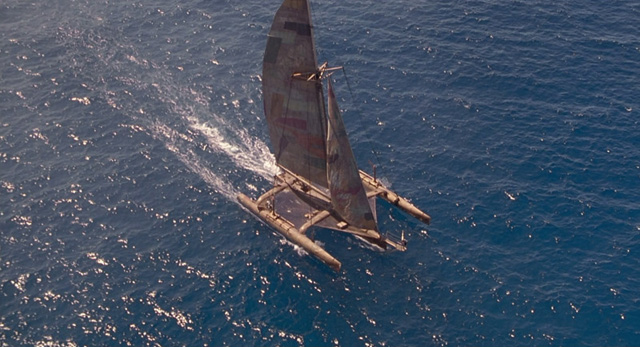
I can’t actually say that I’ve been taking a break from serious movie watching as too much of my regular viewing is, well, less than serious. But I did recently re-visit a handful of genre films which I hadn’t seen in a while. Two of these featured huge budgets and ambitions of scale (and were generally reviled by critics and audiences), while the other two were more modest – but generally more creatively successful.
Waterworld (Kevin Reynolds, 1995)
Waterworld (1995) was the third movie director Kevin Reynolds made with star Kevin Costner and it was, not surprisingly, a troubled production. As all filmmakers know, shooting on water is difficult at the best of times. But to attempt a huge action film which takes place entirely on an endless sea, was an act of sheer hubris. Storms and other more mundane setbacks caused the budget to balloon to about $175,000,000 … and it eventually grossed only half that in the States.
There’s no denying that the movie has issues – not least in its wholesale cribbing from The Road Warrior (1981), failing to disguise its extensive character and plot borrowings despite relocating the action from the desert to the ocean. It even used the same cinematographer, Dean Semler. Cobbled together cars were replaced by cobbled together boats, motorcycles became Sea-Doos. The oil well compound populated by decent but suspicious people became an artificial atoll populated by decent but suspicious people. There’s even a plucky little kid who eventually wins the outsider hero’s heart (here a chatty girl rather than a speechless feral boy). And of course, it’s about a bunch of global catastrophe survivors who dream of making it to a far-off mythical paradise.
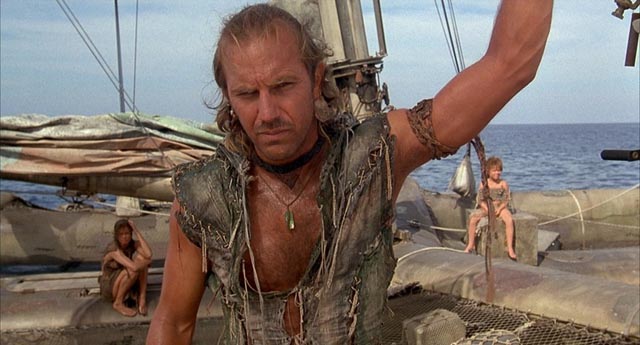
These obvious similarities have the unfortunate effect of highlighting what doesn’t work so well in Waterworld. As entertaining as Dennis Hopper is as the Deacon, leader of a marauding pack of murderous pirates, he lacks the menace of Kjell Nilsson’s Humungous, playing the part more for comedy. And yet the sheer scale of the production, the imaginative design (by Dennis Gassner), and the impressively staged action sequences have much to offer to a genre fan, while – despite much of the criticism – the central thread involving Costner’s Mariner and his two passengers (unwillingly taken aboard his boat), Helen (Jeanne Tripplehorn) and ten-year-old Enola (Tina Majorino), is an engaging bit of sci-fi storytelling.
Costner topped it in every way two years later with The Postman (1997), still vastly underrated, a tonally more coherent post-apocalyptic epic with a similar hero and a much better-realized villain. I’ll have to get around to watching that again some day soon – despite its poor reception, it remains one of the finest pieces of classical narrative filmmaking of the ’90s.
*
Dune (David Lynch, 1984)
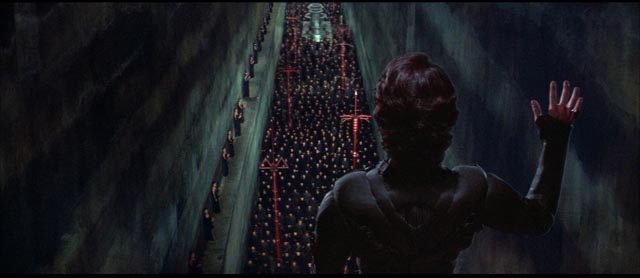
Dune (1984) was always going to be problematic. Frank Herbert’s sprawling sci-fi novel about ecology and messianic religion had already defeated a number of filmmakers (most notably Alejandro Jodorowsky) before Dino De Laurentiis made the strange and commercially risky decision to hire David Lynch – whose only previous credits were Eraserhead and The Elephant Man – to adapt and direct. The result was one of the most famous debacles in movie history, a work mutilated by producer and studio, with a director who has essentially disowned it. (When a friend and I went to a weekend conference on transcendental meditation and creativity at the Maharishi University of Management in Fairfield, Iowa, in 2006 – an event presided over by Lynch – on the first evening all of his movies up to that date were listed by the person introducing him … except for Dune.)
Lynch’s script was extremely dense and used a potentially cumbersome device to get across a lot of information and exposition: each character had an “inner voice” which commented on what was happening. Of course, that required a lot of screen time in which characters stood silently while we heard their thoughts. Right from the earliest days of shooting, this problem was compounded by the very slow pacing of scenes. It was quickly apparent that the long script would end up a very long movie … even though De Laurentiis was contractually obligated to deliver a maximum 130-minute cut to Universal. (The strange rhythms of the dialogue in Eraserhead are ill-suited to a sci-fi epic, but they can be felt at many places throughout Dune.) One of the most amusing aspects of the production, at least to an observer from the sidelines, was watching as the studio sent down suits to rip pages out of the script as it was being shot, while Lynch was quietly writing new scenes to add back in.
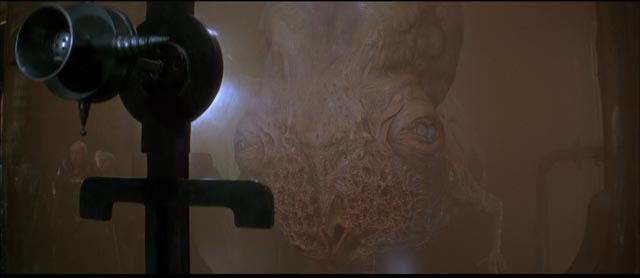
The final film is undeniably clumsy; all the cutting and compression did enormous damage to the narrative, particularly in the mid-section dealing with Paul’s entry into and eventual taking over of the Fremen culture. The acting is uneven, from Kyle MacLachlan’s stiff earnestness (in his first movie role) as Paul to the outrageous hamminess of Kenneth McMillan, Paul L. Smith and Sting as the all-but-moustache-twirling Harkonnen villains. Poor Brad Dourif, Method to the core, never managed to find his inner Mentat and delivered a bewildering array of physical and vocal tics, made all the more bizarre in contrast to the comic comfort displayed by Freddie Jones as his fellow Mentat Thufir Hawat.
And yet Dune remains one of the most richly designed of all sci-fi epics, a film of varied and beautiful visual textures, and an evocation of other worlds which doesn’t feel like variations on what is already familiar. It falls short as a dramatic experience, but is capable of inspiring awe as a cinematic experience.
It’s many years since I’d last seen it and I found it quite unsettling this time as scene after scene triggered personal memories of the production – I was constantly reminded that I had stood on these sets, that I had witnessed these scenes being filmed. So, yes, perhaps the personal connection does colour my response to the film. But I notice that its reputation on IMDb has crept up over the years and that many others also like the film despite (perhaps even in part because of) its flaws. I still daydream that one day someone will come along to assemble a more complete version which remains faithful to Lynch’s intentions – unlike the “extended television cut”, which was an abomination.
*
The other two movies I recently re-visited were both directed by Paul W.S. Anderson, a filmmaker who in some quarters still doesn’t get the respect he deserves.
Event Horizon (Paul W.S. Anderson, 1997)
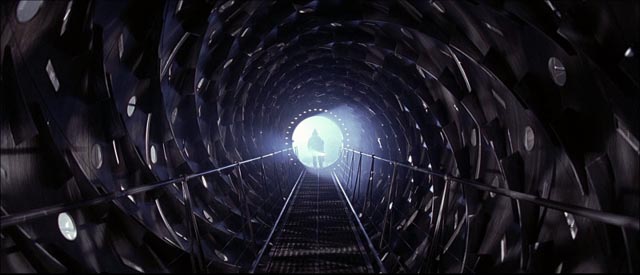
Event Horizon (1997) is, as Anderson says, a haunted house movie in space. A rescue mission is sent to Neptune where the “Event Horizon”, an experimental faster-than-light ship which disappeared seven years ago, has mysteriously reappeared. The rescue ship, the “Lewis and Clark”, is crewed by the same kind of working class technicians who faced the xenomorphs in Alien and Aliens; not brilliant scientists, but just men and women doing a job for pay. That job is essentially the work of a Coast Guard which now extends out through the solar system, looking for the lost and stranded and bringing them home.
On this particular mission, their passenger is Dr. William Weir (Sam Neill), the designer of the missing ship, who is eager to find out what happened to it. But that desire has an unhealthy underpinning, because it’s bound up with a suppressed sense of guilt about the suicide of his wife while he was completely absorbed in the project to design and build the ship. The captain of the “Lewis and Clark”, Miller (Laurence Fishburne), is unhappy about Weir’s presence and the scientist continually rubs him the wrong way by trying to interfere with well-established mission procedures. This conflict rapidly escalates once they reach the “Event Horizon” and discover its crew all dead, its log having recorded a horrific orgy of violence and depravity.
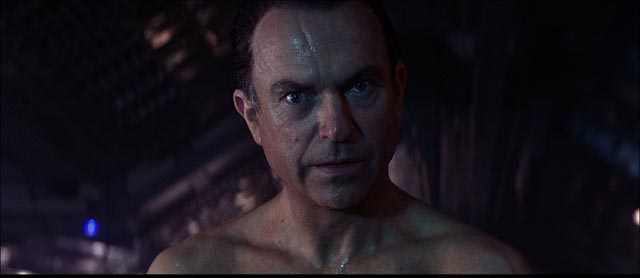
The experimental drive built by Weir was designed to create and contain a small black hole which folds space around the ship, enabling instantaneous passage to other parts of the universe. The question is where did the drive take the ship and why has it reappeared after seven years. As crew members start to have visions which call up buried memories and feelings of guilt about past failings, they begin to die in gruesome ways and Weir becomes increasingly unstable. The thing is, the “Event Horizon” didn’t reach its original intended destination, but rather passed into another dimension … which for want of a better word was Hell. It’s come back possessed by a demonic energy which infects the crew of the rescue ship and completely takes possession of Weir.
Impressively designed by Joseph Bennett and atmospherically shot by Adrian Biddle, who had previously shot James Cameron’s Aliens and had just come off Neil Jordan’s brilliantly twisted The Butcher Boy, Event Horizon is a taut, creepy horror film dressed in sci-fi drag, more akin to Robert Wise’s The Haunting than Ridley Scott’s Alien. I find it odd that some critics and commenters complain about what they perceive as its scientific shortcomings as it establishes itself quite quickly as a horror film which uses sci-fi trappings to provide an interesting setting for what amount to ghosts and demons.
Roger Ebert complained that at its heart this movie is anti-science, anti-knowledge, but by its nature the horror genre is rooted in the irrational and a distrust of the limits of human knowledge. You could make the same complaint about The Exorcist or pretty much any story which brings in ghosts or malevolent spirits, but at some level this is completely irrelevant; such a complaint would sweep away the entire genre, discarding its inherent value as a source of emotional catharsis, a way of facing and coming to terms with our fears, which by their very nature express our uncertainty about what lies outside of the knowledge we have accumulated to date. I’m not religious myself and I have absolutely no belief in Heaven or Hell, demons or angels, God or the Devil – but I do enjoy a well-told story which is rooted in such beliefs, and Event Horizon more than fills the bill.
*
Death Race (Paul W.S. Anderson, 2008)
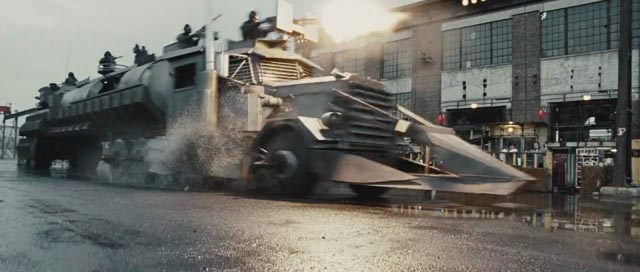
Death Race (2008) is Anderson’s finest film, a grim and gritty reworking of Paul Bartel’s low budget black comedy Death Race 2000 (1975). Bartel’s movie was about a cross-country road race in which drivers scored points not only by running each other off the road but also by killing pedestrians. The whole population joined in, with old folks’ homes wheeling their inhabitants out into the road for Euthanasia Day and rabid fans deliberately sacrificing themselves to help their heroes rack up points. Scripted by Charles B. Griffith and Robert Thom from a story by Ib Melchior, it was a very broad satire of a society which has degenerated to the lowest levels of consumer capitalism, where life and entertainment have become inextricably blended.
With its roots in Elio Petri’s The 10th Victim (1965), it laid the foundation for a whole genre of killer competition movies – from Paul Michael Glaser’s Stephen King adaptation The Running Man (1987) to Daniel Minahan’s Series 7: The Contenders (2001), Neveldine/Taylor’s Gamer (2009) and the Hunger Games series. The central thread common to all these movies is that the killing is broadcast – first on television, later over the Internet – as a form of subscriber entertainment which is manipulated by oppressive governments to distract populations from their own deteriorating economic situation. The not-so-subtle point is that capitalism pits people against one another for its own benefit, reducing society to its basest level with total disregard for the actual quality of life.
In 1975, this could be treated as a gleeful joke. By 2008, it had crept much closer to reality. Made just before the worldwide economic collapse of 2008, Anderson’s version is rooted in the sense of economic precariousness which was unsettling the middle and working classes. In the film, mass unemployment permeates society with despair and incipient violence, with the state imposing increasingly brutal efforts to suppress potential revolt. In addition, pushing a particularly insidious contemporary development to its logical conclusion, this society now has massive privatized prisons whose sole purpose is to exploit prisoners for maximum profits. Hence the development of the Death Race, a pay-per-view streaming competition in which imprisoned drivers compete to the death for the supposed prize of a pardon and release … if only they can win five contests.
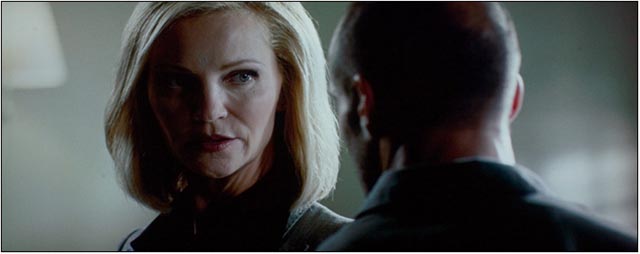
Jason Statham is Jensen Ames, a former race driver, now unemployed, who is framed for the murder of his wife and sent to Terminal Island, a decaying industrial carcass transformed into a prison run by Hennessey (Joan Allen). She’s a coolly cruel administrator who actually commissioned Ames’ wife’s murder in order to get him into the prison to take the place of the most popular racer, Frankenstein, who unfortunately was killed in the last race. Luckily Frankenstein wears a mask, making it possible to replace him endlessly to keep the ratings high.
Needless to say, Ames is smarter than the smug corporate types who want to use him and during the course of the three-day race he forms alliances with opponents and comes up with a scheme to destroy the whole game system from within.
Anderson’s script creates a set of distinctive characters with enough depth to get the audience to invest in their fates, but what really impresses is the way Anderson embeds these characters in the relentless and brutal action of the race itself. The setting provides both an image of real industrial decay and a metaphor for the decline of the West. Filmed in and around a huge decommissioned industrial complex in Montreal, the vehicular mayhem is visceral and exciting (yes, making the movie’s audience complicit in the spectacle of violence and death). The staging, the camerawork, the editing all work together to emphasize the physical danger of the race while maintaining a clear sense of the geography of the track and the relationships among the racers. This is one of Anderson’s strengths, his ability to keep the mayhem coherent (something lacking in Roel Reiné’s two sequels).
The film’s other major strength derives from his insistence that the car action had to be real. By 2008, CGI was ubiquitous in action and fantasy films, but here Anderson used computer imagery for a minimum of visual enhancement; the action was performed by real drivers in real vehicles, giving Death Race the visceral kick which CG movies so often lack. This even extended to the set-piece midway through the race in which an actual semi is flipped end-over-end on the track. Apart from telling a tense, engaging story, Anderson reminds us of the visual pleasures of the real. CG takes the danger out of movie action sequences and, whether entirely conscious of it or not, our brains can tell the difference.
*
For all their differences, these four films all construct elaborate physical worlds within which their action takes place – the massive sets of Dune at Estudios Churubusco in Mexico City, the ships and atolls of Waterworld off the coast of Hawaii, the huge spaceship of Event Horizon built at Pinewood Studios in England, and Death Race’s derelict factory in Montreal. All these films have a physical weight, a depth of texture which supports their stories regardless of whatever script shortcomings they might have. They reconnect the viewer with the original thrill of cinema, the capturing of something in the real world which is then displayed on a screen in the dark for our entertainment.
*
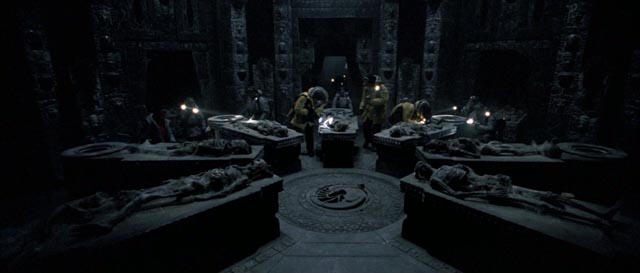
ADDENDUM: After watching Event Horizon and Death Race again, I decided to take another look at my least favourite Paul W.S. Anderson movie, Alien vs Predator (2004). When I first saw it, I hadn’t formed any particular opinion of Anderson – I’d only seen Event Horizon and Soldier, which I liked, and Resident Evil, which seemed pretty disposable at the time (I like it more now in the context of the series). Watching AVP again, I can see that what I didn’t like about it then still holds. First, the whole concept smells of corporate decision making, suits in boardrooms looking to extend not one but two franchises (the same people who thought it would be a good idea for Freddie to meet Jason, and for Batman to duke it out with Superman … I’m surprised we haven’t yet seen Henry the serial killer check in for a stay at the Bates Motel). Whatever skills Anderson brought to the project, there’s really no creative impetus. Everything is invented for base commercial reasons and the result lacks any of the appeal of the two original series. But what’s more obvious now – particularly in light of what I’ve written above – is that the movie relies far too much on CGI, particularly with the aliens (in the disk’s commentary tracks, Anderson and his effects crew talk about doing as much as possible with practical on-set effects, but much of that work, extensively enhanced by CG, takes on the weightless quality of computer imagery). It has little of the authenticity of Anderson’s previous work; so much of the action feels contrived and uninvolving. But that said, he does manage to inject a bit of narrative conviction into the relationship that develops between Sanaa Lathan’s character and the Predator. It’s the one bright spot in the movie … well, that and the unexpected presence of Ewen Bremner, not someone you expect to find in a sci-fi monster movie.
Comments